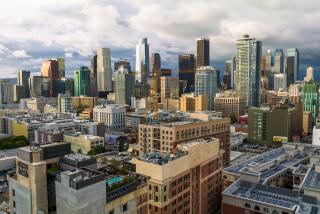Future Sparkles in Resurgent Cleveland
- Share via
CLEVELAND — In Tower City, the centerpiece of this city’s downtown renaissance, visitors pass by fountains and boutiques to consider an exhibit made of cardboard.
They’re looking at a model of downtown Cleveland in the year 2000, a remarkable tangle of hotels, parks, public works and stunning architecture.
Some of the vision could prove to be fantasy. But judging from the cranes towering over the United States’ 12th-largest metropolitan area, much of the construction is already under way. From the shores of Lake Erie to the city’s Public Square, Cleveland is welding and riveting its way into the next century. As the United States slips toward recession, this gritty Rust Belt survivor actually suffers from a shortage of construction workers.
Fueling the activity is Clevelanders’ willingness to spend money, bury their differences and unite around common goals. The city’s experience provides a good lesson for other major cities facing hard times.
Nowhere are the results more evident than downtown, where builders are trying to catch up on decades of pent-up demand. Until recently, Cleveland was a time capsule that preserved old structures because nothing was built to replace them.
Cleveland’s problems were numerous, including a crisis of confidence caused by burning ghettos, bumbling mayors, a river that caught fire and the collapse of its steel, automobile and machine-tool industries. When Cleveland defaulted on its bond obligations in 1978, it looked as if the city might never recover.
But it fought back. Mayor George Voinovich, now governor-elect of Ohio, helped reverse the decline by getting business, political and community leaders to agree on what needed to be done.
“When you had the economic problems we had in the early 1980s, you really didn’t have much choice,” said Richard Shatten, executive vice president of Cleveland Tomorrow, an economic development group made up of chief executives from Cleveland’s 50 largest companies.
What followed was a combination of private and public efforts that reshaped the skyline and fostered employment. One example: A tax abatement to get LTV Steel to invest an additional $1 billion in the area. The effort preserved 6,000 jobs.
Developer Albert Ratner, a Clevelander whose projects include the 16-acre MetroTech development in Brooklyn, N.Y., chipped in by taking on the Terminal Tower, the Depression-era skyscraper that dominates the skyline. He converted the old railroad station at the base of the tower into a splashy development with a Ritz-Carlton hotel and three levels of shopping.
Tower City is only the latest in a series of projects. On the opposite side of Public Square, an office tower being built has surpassed the Terminal Tower as the city’s tallest structure. When completed next fall, the 948-foot bank headquarters will be the tallest building between New York and Chicago.
Then there’s the $344 million Gateway sports complex, a massive project that is getting started on the edge of downtown. In an age of public financing of sports facilities, the project--which includes a stadium for the Indians baseball team and an arena for the Cavaliers basketball team--stands out because of the role played by private investors.
Voters approved a tax on liquor and tobacco to pay half the cost and private investors agreed to pay the rest.
“It’s just fantastic what they’ve done to this city in recent years,” said Bill Carroll, a public affairs manager of Ford Motor Co., the city’s largest private employer, with 17,000 workers. Ford is investing $2 billion in its Cleveland-area factories.
But Cleveland still has serious problems. The city’s schools are considered weak, and old-line manufacturers routinely close plants. Cleveland’s growth still lags behind its rivals, Columbus and Cincinnati.
Yet in a city where one can buy a four-bedroom house in the affluent suburb of Shaker Heights for $129,900, Cleveland has an appeal that should help it over the humps.
More to Read
Sign up for The Wild
We’ll help you find the best places to hike, bike and run, as well as the perfect silent spots for meditation and yoga.
You may occasionally receive promotional content from the Los Angeles Times.






